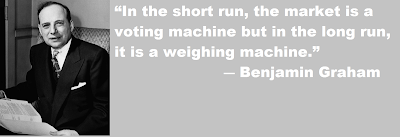 The title states what may be the only thing standing twixt a
satisfied DIY stock investor and a person who throws it over the fence to a
professional. Pundits, talking heads,
and bold media headlines lead would-be DIYers to believe investing in stocks is
rocket science or brain surgery. It’s
not. It does require effort, but not as
much as you think.
The title states what may be the only thing standing twixt a
satisfied DIY stock investor and a person who throws it over the fence to a
professional. Pundits, talking heads,
and bold media headlines lead would-be DIYers to believe investing in stocks is
rocket science or brain surgery. It’s
not. It does require effort, but not as
much as you think.
Bertrand Russel is recognized as making famous the phrase,
“Men would rather die than think. And
most do.” Dividend Farmers who are value
investors and DIYers don’t subscribe to this perspective. Like regular farming, Dividend Farming
requires active participation; consistent and persistent.
An earlier post shared 10
Questions to help you build an investing philosophy. A philosophy is a good framework with which
to start. Eventually we move from
philosophical perspective to the active practice of selecting our first
stock. But how do we do so without
screwing it up?
Benjamin Graham, the godfather of value investing offers
advice about this in his work, Security
Analysis. In it he summarizes three
hurdles investors face when selecting stocks.
First: Overcoming inadequate or incorrect data. As a pilot, the phrase, “Good information
leads to good decisions,” quickly comes to mind. Another way to look at is GIGO or garbage in
/ garbage out. However you wish to view
it, the first thing is to develop solid information. This means reviewing company data from Yahoo
Finance, your brokerage’s online tools, or similarly recognized and trusted
sources. This is the entry point of your
selection activity and the first line of risk mitigation.
Dividend
Farming: Selecting Investments provides a list of specific steps and
resources you may consider in developing your selection information. Posts about SO,
GD,
MSFT,
UTX,
GIS,
and DE,
offer examples about how information might come together in usable form. However you do it, take the time to find a
method for gathering adequate and correct data that works for you.
Second: Minimize volatility. Companies with long records of
stable earnings growth are likely to produce similar growth in the future versus
companies with abrupt or large-scale fluctuations in market price. Stable firms with strong histories are less
likely to see serious declines as well.
This makes them less risky.
Dividend Champions are great options for minimizing risk and
volatility.
Third: Focus on the market weighing machine; not the
voting machine. Weighing a company
means assessing its (intrinsic) value.
Voting a company is a popularity contest. The second is meaningful in high school. Not so when investing; unless you’re a
momentum investor speculator.
 |
| Focus on value, not popularity. |
Assessing a firm’s value usually means estimating the cash
it can provide over time (dividends, for instance) and measuring that cash
flow against the price the market has voted for the day. Predicting future cash flows from stable
dividend payers is easier than forecasting similar flows from companies with
wildly gyrating earnings growth or no dividend payments. You’ll find yourself focusing on weight
versus popularity if you stick with stable dividend payers.
In each case, Graham tells us risk mitigation and margin of
safety in our selection process is important. Graham’s guidance offers a method for selecting our
investments without screwing it up. As Roger Lowenstein said, “Avoiding
serious loss is a precondition for sustaining a high compound
rate of growth”. Words of investing
wisdom, indeed!
The
opinions expressed here are those of the author; not a financial professional.
Perspectives offered should not be considered investment advice. They are
presented for discussion and entertainment purposes only. For specific
investment advice or assistance, please contact a registered investment
advisor, licensed broker, or other financial professional.
No comments:
Post a Comment